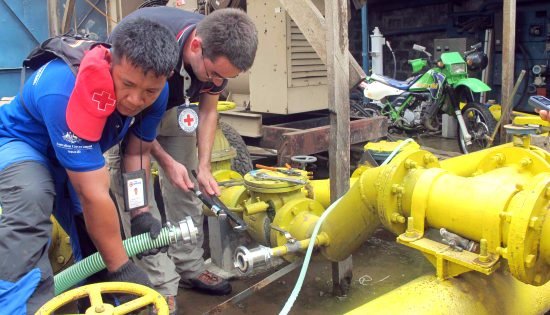ICRC responds to
urgent needs in aftermath of Sendong
|

Water
and habitat specialists from the ICRC and Philippine Red Cross
connect pipelines to the main source of the Cagayan de Oro Water
District. (ICRC / Olav Sinsuat) |
By ICRC
December
22, 2011
In the aftermath of
tropical storm Sendong (Washi), one of the most pressing problems is a
lack of access to drinking water. Andres Casal, the ICRC's water and
habitat coordinator in the Philippines, gives us an update on the
current situation and the humanitarian response.
How did the ICRC react
when the storm hit?
As Sendong left
destruction behind on its path across the southern Philippines, the
ICRC immediately mobilized emergency support for the relief operations
led by its local partner, the Philippine Red Cross. The aftermath was
particularly devastating because the storm hit parts of the country
that do not usually experience typhoons. Food packs, essential
household items and hygiene kits for 18,000 people were distributed in
Cagayan de Oro, Illigan and Bukidnon (three of the areas hardest hit)
within the first 48 hours – a crucial period for life-saving action in
such an emergency.
The ICRC adapted its
activities to meet a range of humanitarian needs arising in the days
that followed. Together with partners in the International Red Cross
and Red Crescent Movement, the ICRC stepped up its response.
What's the situation
like on the ground?
I'm currently working
in Cagayan de Oro, one of the places that was the worst hit by the
storm. Along the Cagayan River, which overflowed and caused the
flooding, there is mud and debris everywhere. Both sides of the river
have been ravaged. Some people are starting to leave evacuation
centres to rebuild their homes or to stay with relatives or host
families. But many centres are still filled with families who lost
everything in the disaster. The main concern now is that more than
270,000 people – some housed in evacuation centres, some living in
nearby communities – lack access to drinking water.
Cagayan de Oro is a
big city and not all areas were affected. However, even in some of the
areas that are relatively unscathed, we can sense that there is a
problem because we see a lot of people standing along the road with
jerrycans and waiting for water trucks to come.
What caused the lack
of access to water?
All along the river,
the flooding damaged not only the water pipelines and network but also
many of the wells that were the source of the water supply. While communities can
still rely on the wells that survived the storm, the damaged
infrastructure limits the ability of the local water company to
deliver or store water.
What is the ICRC doing
to meet the need for clean water?
Earlier this week, to
support the Philippine Red Cross disaster management team, we
immediately sent specialized water and habitat engineers to this area.
We are devising ways of bringing water from the undamaged water
sources and of storing it for use by the flood survivors and
neighbouring communities.
The ICRC is increasing
storage capacity by setting up water bladders and tap stands designed
for these kinds of emergencies. We set up the equipment in strategic
places in districts where there is no access to water, such as near
barangay (community) halls. We are also connecting tap stands directly
to water pumping stations that still function so that the water can
reach even more people.
The ICRC is working
closely with the Philippine Red Cross and local water district to
ensure that water tanks and bladders are continually refilled. In a
short time, we have already been able to make water available to
13,000 people, and this work continues.
In the coming
weeks, it will be the job of the local water district to restore as
quickly as possible their capacity to deliver water to the
flood-stricken areas. The ICRC will support these efforts. Our staff
remain very motivated and we will continue to deal with needs as they
arise.